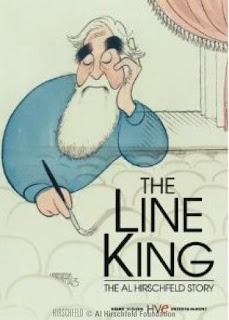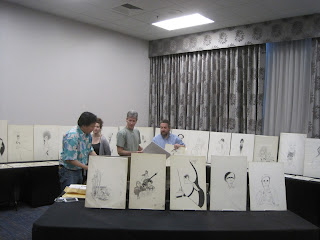and author. His most recent book is "The Hirschfeld Century" http://stuartngbooks.com/the-hirschfeld-century-portrait-of-an-artist-and-his-age.html
First stop was the DreamWorks studios animation campus. David was in the Los Angeles area, giving lectures at various art schools and animation studios.
For the DreamWorks talk, David and Foundation archives manager Katherine were guests of the DreamWorks artist development department.... where Angela (Production Manager for Artist Education) oversees an ongoing program of classes and guest appearances.
Lectures like David's are recorded, so DreamWorks artists who can't attend can still have access to these fantastic educational opportunities. David graciously signed copies of his new book before and after the presentation.
David gave his talk in the Campanile Theater. The big screen and comfy seats were the perfect setting for David's slide show of images with highlights from Hirschfeld's 70-year career
The style of David's talk was very conversational... relaying background about Hirschfeld the man as well as the artist and the development of his characteristic style.
He began this talk by familiarizing the audience with the one-night art show later that evening as well as the goals of the Al Hirschfeld Foundation http://www.alhirschfeldfoundation.org/
... to continue the legacy of the artist, focusing on education and promoting theater and cultural arts. One of the current projects is bringing art-themed educational programs to schools. The Foundation also mounts exhibitions all over the world and provides grants to cultural institutions. One of the ways the Foundation funds its mission is via the sale of Hirschfeld originals...like the works on view at the art exhibit later that evening.
Here are my notes on just a few of the insights David shared during this DreamWorks talk:
Hirschfeld's wickedly fluid, action-evoking and emotion-revealing ink line wasn't a single stroke. It was actually the result of many, many tiny pen scratches.. going over the pencil drawing on the board to achieve the effect (he would erase the pencil lines later). The sound of the pen nib scratching into the surface of the board is a lingering memory from David's years working along side Hirschfeld as his personal archivist.
Hirschfeld's tools were pencil, pen and paper. As his career progressed, he hoped to get good enough to eliminate the pencil from his tool kit. He knew about the tools of the modern age... and tried out computer art equipment like a Wacom tablet... but those options arrived at a point in his career when he was more interested in simplification.
Here's a link to a video of Hirchfeld drawing from the DVD for "The Line King"...http://www.alhirschfeldfoundation.org/screeningroom
Many more people saw Hirschfeld's drawings than ever saw the actual productions he immortalized. His drawings weren't concerned about plot.. He captured the movement and emotions of the moments that make theater come alive. Newspaper readers who were not in the audience felt they had seen the play -- solely from impressions formed by a Hirchfeld drawing.
He embraced all artists as peers and colleagues. He worked for a number of papers and was comfortable in the world of journalism. Reporters used words to deliver the facts of the story.. and Hirchfeld would sometimes use photo reference for the plays he covered. However, Hirschfeld's goal was to produce visual journalism that showed in images how the experience felt.
Mindful of his audience for this particular talk, David explored how Hirchfeld shared an animator's affinity for conveying characters in graphic terms.. finding the right line.. and action... that would make people who were viewing a drawing get emotional impact and really care about was was being conveyed to them in the form of pencil lines on paper.
Early friendships in his career with icons like John Held Jr and Miguel Covarrubias were just the beginning of Hirschfeld's long association with key figures the the arts. David also discussed the cliches about caricature, along with what happens when the line goes beyond cartoonish effects but uses exaggeration to the point that it makes things more real.
Actors would win awards over their careers.. but the item they cherished and showed to their friends was the Hirchfeld. They praised Hirschfeld's talent for capturing the range of their entire performance... or even their career.. in a portrait or sequence of poses. One example David cited: the "look" of the famous Marx Brothers evolved to reflect how they were depicted by Hirschfeld. Film studio hair dressers even styled triangle shapes into Groucho's hair to echo the Hirchfeld work. The classic comedy team of Laurel and Hardy were also shaped by Hirschfeld's renderings. He thought they resembled the number "10"... and expressed that in iconic posters for their most enduring films. This image of Laurel and Hardy also documents Hirschfelds multi-media work: the bedspread is made from wallpaper samples:
While Hirschfeld drew for The New York Times every other week for over 70 years.. those drawings represent only about half of his total work.
He started in film and advertising art... doing representational illustrations and decorative work. During the 1920s, he was going back and forth between Paris and New York. His early career included record album covers for hot jazz artists. Album cover assignments extended into the 1970s, with "gateway" drawings like the cover for the famous "Draw The Line" album by the rock band Aerosmith.
The talk included the origin of the famous "Nina" signatures..... and even mentioned Hirschfeld's time on a baseball team with Lou Gehrig.. .. but there wasn't time to go into many other topics, such as his travels in Bali and the art he made.. discover those stories and images in David's book :)
Hirschfeld's optimism infused his life and work ethic. It made him a cherished friend to famous figures across decades of art, culture and history. A look at Hirschfeld is an inspiring example on many levels....
After decades at the New York Times, with expansive Hirschfeld drawings on the prestigious "above the fold" area of the paper, orders from the executive offices moved the theater coverage to inside pages. Hirschfeld's wasn't phased by this. Instead he seized the challenge for these new "Friday Pages." He produced work that was just as memorable and powerful.. in spite of a strict narrow, vertical orientation for the drawings. He was so successful at this transition, most readers didn't really notice the dictated changes. The Friday Pages went on for 14 years. The master evolved. He was never content to keep doing the same thing.
After a delightful lunch with Education Manager Angela... the SNB team headed over to the Burbank Marriott hotel. David had been able to bring some artwork on short notice.. and had reached out to Stuart to help get an art exhibit together.
David and Katherine met us there... and the exhibit began to unfold...
Notice for the event appeared on the SNB email newsletter, website and Facebook page. Over 100 people RSVPd...
The crowd was brimming with working professionals.. collectors .. and fans. All eager to see these originals up close...
David was on hand to answer questions and sign books. In the photo below, he's chatting with Tom Sito... animator at Disney and DreamWorks .. and currently Chair and Professor of the John C Hench Division of Animation and Digital Arts at the School of Cinematic Arts at USC.
...which David kindly signed for our inventory. The book is full of images that haven't been included in any previous collection.
Thanks so much to David and Katherine... along with SNB pal Mary and crew member Jim for all their help with an eventful evening!




















No comments:
Post a Comment